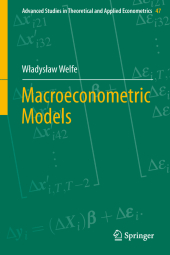 Neuerscheinungen 2015Stand: 2020-02-01 |
Schnellsuche
ISBN/Stichwort/Autor
|
Herderstraße 10
10625 Berlin
Tel.: 030 315 714 16
Fax 030 315 714 14
info@buchspektrum.de |

Wladyslaw Welfe
Macroeconometric Models
2013. 2015. xxvii, 425 S. 5 SW-Abb. 235 mm
Verlag/Jahr: SPRINGER, BERLIN; SPRINGER BERLIN HEIDELBERG 2015
ISBN: 3-642-44014-2 (3642440142)
Neue ISBN: 978-3-642-44014-4 (9783642440144)
Preis und Lieferzeit: Bitte klicken
This thorough guide covers the history of macroeconometric model building, summarizes the development and structure of macroeconometric models built in North America, Europe and elsewhere and covers the systematic characteristics of macroeconometric models.
This book gives a comprehensive description of macroeconometric modeling and its development over time. The first part depicts the history of macroeconometric model building, starting with Jan Tinbergen´s and Lawrence R. Klein´s contributions. It is unique in summarizing the development and specific structure of macroeconometric models built in North America, Europe, and various other parts of the world. The work thus offers an extensive source for researchers in the field. The second part of the book covers the systematic characteristics of macroeconometric models. It includes the household and enterprise sectors, disequilibria, financial flows, and money market sectors.
The History in Outline: The Origins of Macroeconometric Models.- Macroeconometric Models of the United States and Canada.- Modelling Activities in Europe.- Models of the French Economy.- Dutch Macroeconometric Models.- The Models of the Nordic and Baltic Countries.- Models of the Central and South European Countries.- The Models of the Middle and East European Countries.- The Macroeconometric Models of the European Union and the EURO area.- The Macroeconometric Models of the Rest of the World Countries.- Macroeconometric Multicountry Models.- The Structure of Macroeconometric Models: Introduction.- Macroeconometric Models - The Classification.- Modelling the Behaviour of Household.- The Models of the Enterprise Sector.- Modelling Disequilibria and Equilibria.-Modelling the Financial Flows.- Modelling the Money and Capital Markets.- Prospects of Macroeconometric Modelling. _
"The book gives a comprehensive survey of the history of macro-econometric modelling (Part 1) and of the development of econometric models over time (Part 2). It is well written and clearly arranged and will certainly become an important reference for economists." (Peter Hackl, Statistical Papers, Vol. 56, 2015)


